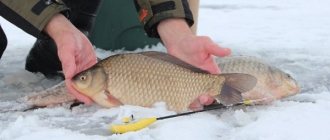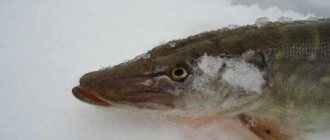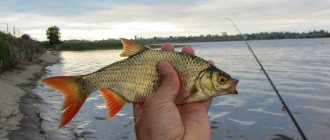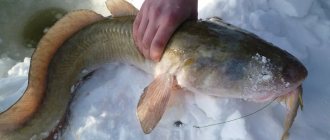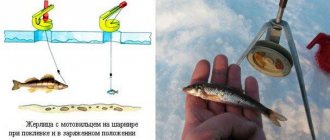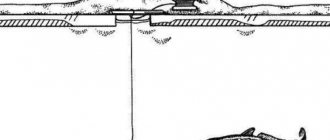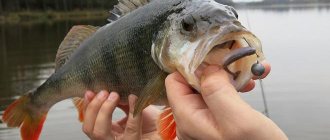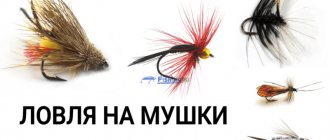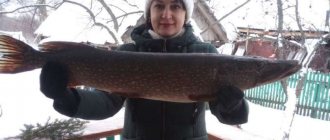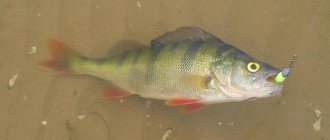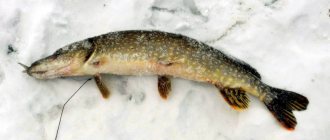The device of the girder with a flag
There are 2 types of vent devices. This is a classic flag, in which the flag begins to shoot out of the reel when biting, and the beacon lights up with a bright light visible on the white background of snow.
The second version of the device consists of a flag and a fishing line wound around it. When a fish bites, it begins to turn over and enter the predator’s mouth. The amount of fishing line wound is of great importance.
According to the recommendations of professionals, it should be about 20-30 meters long for fishing in shallow and medium depths. Live bait must be pierced in the back area.
Preparation for fishing with flags
Selecting a location
The choice of location must be taken seriously. The catch and the effort and time spent depend on it. To avoid wasting time, you need to understand the habitats of predatory fish (in winter). In these places you need to start placing the guards with flags.
The time of year is also taken into account. By the beginning of the winter season there are a lot of fish in the habitats, but closer to the middle of winter there are much fewer. Large specimens (pike) are caught towards the end of winter. Shallow water is where predatory fish go to spawn.
The pike at this time is in the uppermost layers, where it can barely fit. If the bait is below such a layer (1-2 meters), then the pike will not notice the prey and will swim past.
Note! Don’t forget about the location of pikes’ organs of vision at the top of their heads. In biting areas, you need to keep live bait in a jar of water on hand to avoid their death. The main thing here is live bait and fishing spots.
Choice of live bait
In winter, 3 types of live bait are used for fishing:
- Pike and pike perch bite well on perch, which are in great short supply in winter and it is difficult for predators to find them due to the difference in the water layers of their habitat. Here flags and girders come in handy.
- A universal live bait is the gudgeon. It comes to help the fisherman in shallow and deep water.
- The next live bait is crucian carp. It is good for deep fishing for pike.
Note ! It is recommended to have several types of live bait with you (both small and larger).
Where to place the checkboxes?
Ideal places for placing devices would be habitats of reeds and thickets. It is recommended to place them near a not very sharp coastal slope.
At a coastal location, the depth should be no more than 1-3 meters. The footage may vary depending on the location of snags and depressions under the ice by 1-1.5 meters. Typically, it is in such places that predatory fish (especially pike) live all winter.
According to the placement method, the distance between devices should be at least 30 meters. When predators are less active, the placement is carried out at a smaller distance from each other. If the alignment is not along the coastline, then you can try various combinations such as a chessboard.
Good to know! If one tactic does not work, you should quickly change it to another.
You should not keep the rig near the hole for more than 2-4 hours at a time. Fishermen recommend constantly changing them.
Flag fishing tactics
- First you need to start with deeper areas for live bait fishing. The pike begins to move from deep to shallow water.
- Then you can also move the vent to shallow water.
- In the evening it is recommended to return to deep water.
- You can place the vents in the area of snags, holes, dumps, and windbreaks. Typically, predatory fish bite well in shallow water, in snags.
- A good catch can be achieved by placing several devices with flags on a pond (from 8-10 pieces).
- The rules for arranging vents state that they need to be distributed over a range of depths. Here you get a large number of devices, but the catch will also please you many times over.
- It is also worth looking at the weather conditions. Often they can simply interfere with a good bite. Usually this is: high humidity; very low temperatures; high pressure.
Want to know more?
Then head to the special sections of our forum, where you can ask any questions related not only to the choice of a girder, but also to the tactics of fishing with this type of gear!
- Winter fishing;
- Tactics of fishing with a zherlitsa;
- Tactics for catching pike with a girder;
- How to choose live bait for a zherlitsa;
- How to choose a leash for a harness;
- Review, modification and tuning of the “Terminator” girder.
Friends, first of all, the article we presented is aimed at those who are thinking about pole gear for the first time, and are planning to purchase their first pole in the near future, and go to the pond - test their strength and acquired knowledge. We hope that after reading the article, beginners will catch their first pike and get unforgettable emotions from catching toothy predators with this tackle.
Winter fishing with flags
Pike fishing
- In winter, you can catch pike weighing 1-3 kilograms.
- Catching pike with flags (jars) is done with live bait, which is crucian carp or small perch. Roach, gudgeon and silver bream are also suitable.
- The baitfish is inserted through the dorsal fin so that it does not feel much pain and remains alive and active for a long time.
- Pike has a very sensitive sense of smell, which reacts sharply to foreign odors.
- You need to use only thick fishing line so that the fish cannot bite through it.
- When biting, the reel begins to spin and the flag twitches.
- You must pull out the fish carefully, without breaking the fishing line.
Perch fishing
- For perch, use a single hook and a leash with a breaking load of 6 kilograms.
- For better swallowing of bait, the hook is glued to the knot of the fishing line.
- The best place for perch fishing is under the snags.
- The perch usually bites right under the hole, without unwinding the line too much.
- The best bait to use is a small minnow.
Fishing for pike perch
- It is recommended to catch pike perch when the ice thickness is 8-10 meters.
- The location must be chosen on breaks in the relief or pre-channel holes. There may also be breams there.
- The hook should be chosen as for perch - single.
- The length of the leash should be at least 50 centimeters, and it is better to use a fishing line with a diameter of 0.2.
- As live bait they use: bleak; verkhovka or roach.
- It is better to pull out the pike perch very quickly to avoid it going under the snags.
Content
- Catching pike on girders in winter
- Types of vents With a wide base
- With legs
- With slats
Zherlitsa fishing is one of the most exciting and exciting types of winter fishing. However, all the delights of this species can only be experienced when your goal is to catch a spotted predator, that is, pike.

How to make your own fishing flags?
For this purpose, you will need several elements that cost very little. Here's a step-by-step guide on how to complete fishing flags.
Materials:
- You need to take simple, cheap and short kebab sticks (about 300 millimeters);
- You will also need multi-colored cocktail straws;
- Simple folders or their trimmed pieces;
- Stapler;
The process itself:
- You need to cut out triangles of any size from colored folders;
- One side of the triangle must be stapled with a cocktail straw;
- You need to insert about 2 kebab sticks into each tube;
- These flags are placed next to holes on the ice.
Reviews from fishermen
I’ve always been used to doing everything with my own hands: lures and bait; spoon. I like the activity for the sake of experimentation. At home I made such a structure from a sheet of plastic, a reel, fishing line, bright material and live bait. Everything is working. The main thing here is choosing a place for fishing. It must be fishy. Grade:
Seva, 37 years old
I always went fishing in winter with a fishing rod. I read reviews on the Internet about the use of different techniques. This device is quite inexpensive and accessible. They write that you can have a good catch if you place several pieces at once. I'll probably try this method. Grade:
Stanislav, 30 years old
Every winter my comrades and I set up girders with bright flags on the ice. During the winter there is a decent catch. It is interesting to observe the structure here and hook a pike. I read reviews about making girders yourself. I can say that it is easier to buy in a store. The price for them is quite small. Making houses like this is a waste of time. Grade:
Vladimir, 40 years old
For fun, I made a zherlitsa with my own hands, attached bright flags and a reel to it. Then I bought a plastic thing from an online store and started fishing with it. I didn't notice any difference. The cost of the product is inexpensive, so I think my purchase will be useful. I can’t say that I caught a lot of fish – 5 pike. The device is designed for predatory fish. I advise you to try this design for fun. Grade:
Artem, 31 years old
I used this method once. I used purchased girders for 90 rubles. I don’t see the point in making these on my own. I remember catching 2 pike and that’s it. Now I’m sitting with Donka in the winter. Grade:
Arkhip, 29 years old
Let's celebrate! Based on feedback from fishermen, it is clear that many of them carry out the flagging themselves. Many of them advise placing them during winter fishing only when a sufficiently strong ice edge has formed. Care must be taken to avoid getting caught in the wormwood.
Making an over-ice vent
As already mentioned, the easiest way to assemble a girder for winter fishing is from components purchased in a store.
We will need:
- circle base with a radial slot;
- signaling flag on a flexible, springy holder;
- reel-reel with fastening;
- for equipment: fishing line, leash, weight and hook.
If the winter girder is purchased as a complete set, then on the base there will be connectors for attaching a reel and a flag. All you have to do is equip the reel.
If you want to make winter girders for pike completely with your own hands, you can replace store-bought components as follows:
- Circle base It is often sold separately, its price is not high and the easiest way is to buy it, but it can also be cut out of plastic or wood. The main thing is that its diameter is slightly larger than the diameter of the hole.
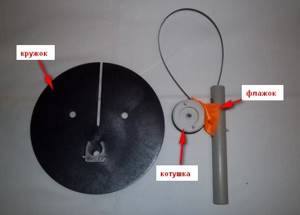
- The signaling flag is also sold separately. If you do it yourself, the elastic holder can be made from spring wire with a diameter of no more than 1 mm, or from elastic plastic, which is used for various packaging, cut from the edges. The length of the holder is 25 - 40 cm. The flag itself is made of bright lining fabric, red or orange, since these are the colors that are best visible against the background of snow. They fasten it by drilling a hole in the base and inserting a rigid bushing there, or by pressing the lower edge of the holder bent at 90° with a plate or washer.
- The reel is usually taken for a winter fishing rod. They attach it to the base either by drilling two holes in the coil bracket, or using electrical tape to a homemade holder.
At home, you can make a girder that solves both the problem of attaching the coil and flag to the base, allows you to better see the signal, and saves the coil from being covered with snow.
For it you will need:

- A base with a slot, preferably purchased, but homemade is also possible;
- A plastic or metal-plastic water pipe of small diameter, 30 cm per vent;
- A clip-mount for this tube (during construction they are used to attach these pipes to the wall);
- Two self-tapping screws, 5 mm longer than the thickness of the clip;
- Small reel for winter fishing rod;
- Signal flag, again purchased or homemade
- Insulating tape.
The assembly order is as follows:
- We fasten the clip with two self-tapping screws to the base, at a distance from its center, slightly larger than the diameter of the coil;
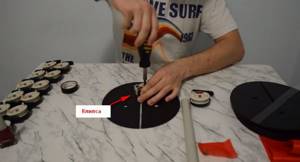
- We wrap a coil of electrical tape to the previously cut tube, just below the top edge;
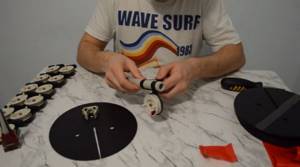
- We insert a 30 cm long tube into the clip;
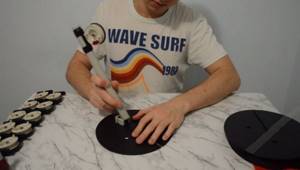
- The flag can also be attached to the tube with electrical tape, or it can be inserted into the tube itself by pressing it with a wine stopper or other plug of a suitable diameter.
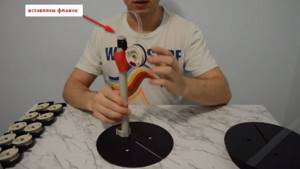
The vent is ready, it is dismountable and can be easily assembled on site, just insert the holder tube into the clip and attach the flag.
We will look at how to equip a winter fishing rod for pike below.
